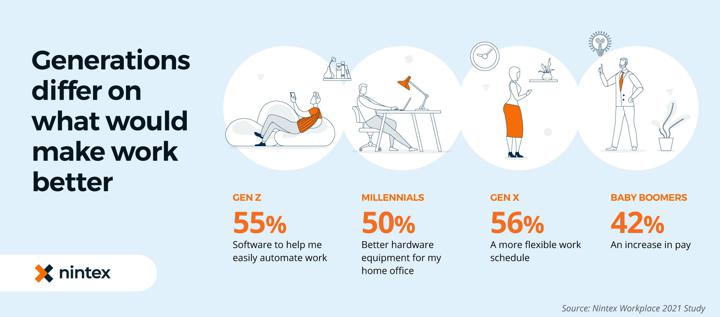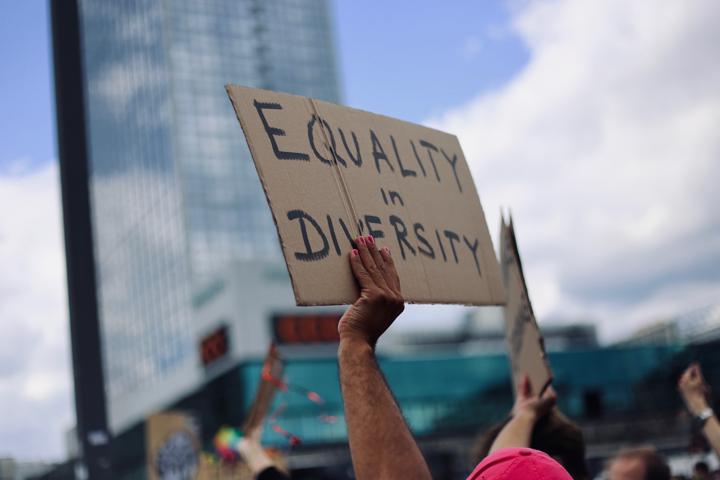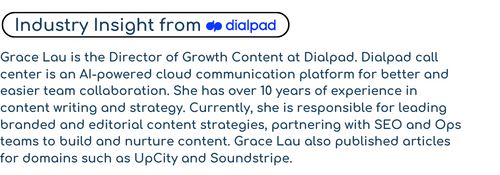
With people today working longer than ever before and labor markets tight, organizations must thread the needle of a rapidly aging workforce. That means creating opportunities to nurture young talent while making sure seasoned staff feel included and get to develop their own aptitudes.
The benefits of managing generational differences go well beyond the moral argument for greater workforce diversity and inclusion. The financial impact is clear. Just as a company might launch a brand ambassador program to improve sales, investing in strategies for managing unprecedented age diversity can help companies grow their market share, lower turnover, and become more profitable when compared to companies that don’t take action.
Better understanding and cooperation can also help increase innovation and lead to improved organizational performance.
Despite this, the benefits of assembling a workforce diverse in thought and experience can sometimes be overlooked.
The pandemic sped up many existing trends in the working environment, such as remote working, flexible hours, and the adoption of emerging technologies, such as an omnichannel contact center, helped organizations rapidly adapt to the radical reordering of working lives.
Intriguingly, evidence from one survey throws light on distinct yet surprising generational differences in how each group experienced and coped with the changes to their ways of working.
While older employees seemed to adapt better to the new conditions, the data revealed no significant differences in how each age group took to unfamiliar digital tools.
Older people set in their ways and only digital natives being comfortable with technology? So much for that.
Given all this, how can we manage the multigenerational workplace? How do we outgrow the ‘us and them’ mindset, go beyond peaceful coexistence, and start leveraging the significant advantages generational and age diversity can bring?
Instead of viewing differences as a source of rifts, competition, and conflict, it’s possible to see the power inherent in generational diversity and the opportunity to unlock the talent that it presents. With the right management strategies, leaders can debunk this negative narrative.
Here are the five most important:
Resist stereotypes
An overwhelming majority of companies still leave age out of their diversity and inclusion programs. As a result, most employees are navigating the generational divide with no support.
One problem is that so much of the media-driven generational conversation trafficks in clickbait headlines and false stereotypes.
Egging on generational conflict, the media signals to leaders and employees that assigning generalized traits to an entire group of people based on their generational identity is socially acceptable.
Ageism is arguably one of the most widely tolerated kinds of workplace discrimination. Growing awareness of the importance and value of diversity has meant that social stigma attaches to most other biases. This is a good thing, though it’s not to say that these forms of bias have been eradicated.
But there’s less attention paid to how ageist attitudes can harm employee productivity and relations. It can leave some workers feeling flawed or judged, even before entering the workplace.
Each generation shares, and is shaped by, the experience of starting their professional lives under certain formative conditions - caused by vast impersonal forces totally out of their control. For example, while younger generations might value flexible working options, veterans might put a higher value on job security.
But whereas age stereotypes hold that every person reacts to the realities their generation face in the same ways, they don’t.
True, we need to understand the nuances between different cohorts. And we also need to realize that relying on a purely generational lens to understand the workforce is flawed.
The first step in understanding age differences at work is suspending our natural inclination to draw hasty conclusions about people. Managers need to be aware of the biases they enact themselves and call out any automatic assumptions they see others making.
Age diversity can be a driver of more discrimination if we don’t shatter intergenerational stereotypes. If we cannot educate ourselves, we’re squandering the value of seeing differences at work as an asset and as resources for fresh perspectives and new ways of problem-solving.
Manage expectations by communicating preferences
A thriving workforce also depends on getting to the root of why different age cohorts approach their work in particular ways.
To see past our own norms and preferences, we need to look at the intentions behind how others act. Good communication is key to understanding your colleagues' preferred way of working. Here are some communication strategies for remote teams.
While many workplace behaviors are not inherently good or bad, they can produce different reactions across age cohorts.
For instance, some people prefer hard copies of documents because it helps them focus without distractions. Authors like Jonathan Franzen and Zadie Smith famously prefer to work on laptops with the wifi disconnected, removing even the possibility of losing themselves in an internet wormhole.
Ultimately, there’s no right or wrong work style or method of communication. What is less than ideal is our ingrained tendency to remain stuck in our own frame of reference, oblivious to how our actions might impact others.
The antidote is cultivating the habit of asking questions about attitudes different from our own and being open about our preferences. Managers should regularly seek and provide feedback to discover the interactions their older and younger employees prefer and identify where any potential problems lie.

Whether it’s talking to colleagues in-person to build relationships, going over a business agreement template with a customer on the phone, or making do with email or text, getting the right blend of communication methods will depend on the goal of the conversations and what feels most comfortable for your employees.
Remember, differences are opportunities to learn from each other.
Strengthen trust
When tasked with working with people whom we view as differing from ourselves, human nature invariably gets in the way.
The more age groups see themselves as diverging in their values or working styles, the harder it is to develop mutual respect and a sense of each other as reliable partners.
Trust is as hard-won between generations as it is essential for teams to flourish.
How do you strengthen trust in your organization? You build psychological safety. Start by creating a conducive environment where team members from different generations feel comfortable simply being themselves and confident in giving their two cents.
One of the chief management challenges leaders face is respecting the varied beliefs and values of older and younger staff while still upholding the boundaries and values of the organization. Because younger generations are as often as not more progressive on social issues, discussions about diversity in a professional setting can be challenging.
Accept that not everyone will always agree. When broaching thorny issues, along with legal and moral perspectives, it's helpful to anchor the conversation in a discussion of their relevance to the organization’s overall mission.
Leaders can facilitate regular meetings to build team safety, foster open dialogue, and inclusive decision making. That might mean giving quiet team members the chance to speak out or catching yourself from shutting down outspoken employees and giving them space to weigh in with their insights.
It’s critical to open up a conversation about the shared norms that help intergenerational teams do their best work. What conditions support them to share their best ideas - a new eCommerce product video, for example - ask for help, and take risks?

It not only brings together the team to chat about a range of work topics. It also helps intergenerational colleagues locate common ground where particular viewpoints or issues are concerned and understand why one might see the same situation differently from another.
Employees will feel more involved knowing that their voice is heard, and their contributions are legitimate. The upshot? Stronger collaborations and more cohesion.
Focus on collaboration rather than competition
Age polarization arises in the workplace as people naturally gravitate to their in-groups. To reduce this, leaders can proactively ensure team members from different generations have ample opportunities to interact and spend time on shared tasks. Teams working towards their full potential should shift from a scarcity mindset to a new frame with a focus on cooperation, reciprocity, and knowledge sharing.
Each generation brings its own unique perspectives and insights. Partnering older and younger employees on projects or during employee onboarding encourages them to impart that knowledge.
You’ll reveal individual and complementary strengths and expertise on, say, using SEO for a better customer experience. And you’re also replacing reflexive assumptions with personal connections and dissolving these fault lines.
Or take the case of younger leaders and older employees. By acknowledging the unique knowledge and experience colleagues bring to the team, leaders will bring them on as allies, building a mutually beneficial relationship in which both are more productive. It works in both directions.
Rather than interpreting every situation as competitive, it pays to find win-win opportunities. Collaboration is key to reaping non-zero-sum gains.
You can also use icebreakers to hit on the knowledge colleagues possess, promote continuous learning, and uncover a wealth of fruitful collaborations. Mutual mentoring programs are another promising initiative.
Develop personalized policies
In uncertain times, organizations must develop policies and benefits that foster motivation and inclusivity and support the ever more complex needs of employees. A one size fits all policy towards benefits and perks won’t suffice. Successful multigenerational workplaces cater to all.
Employees of all ages will appreciate health and well-being programs, retirement savings options, and rewards for long service. Be sure to do your research and customize what you offer to meet your employees’ generational needs.
Above all, organizations need to recognize the complexity of the modern workplace. With so many employee situations, styles, backgrounds, and interests, they need to take an open-minded and flexible approach.
Flexible working options are likely to be in high demand across the board, from parents of young children to seasoned workers enjoying the latitude to tailor schedules to their own personal commitments. Of course, this benefits businesses too, in training and supporting a team of remote agents as part of a more efficient inbound calling strategy.
That said, the COVID-19 crisis showed that demographic profiling is an inadequate lens through which to target employees with the right support.
Instead of premising talent management strategies on employees’ age, a more meaningful intervention is to focus on their attitudes and behaviors.
It takes all kinds to make a world
There you have it - five best practices for managing up to five generations in the workplace, and counting.
Managing generational diversity is a no-brainer and diversity management software can help. More flexible organizations are more rewarding for people, allowing them to play to their strengths and bring to bear their own distinctiveness. And it helps companies attract new talent that increasingly values work-life balance.
The aptness of each generation to paint the other as enemies rather than allies can be a headache for everyone. So break down barriers, change the narrative, get curious, listen and engage with your workforce to understand differences and create an ethos of support and trust. Diversity of thought begets diversity of insights, better decisions, and, ultimately, success.

